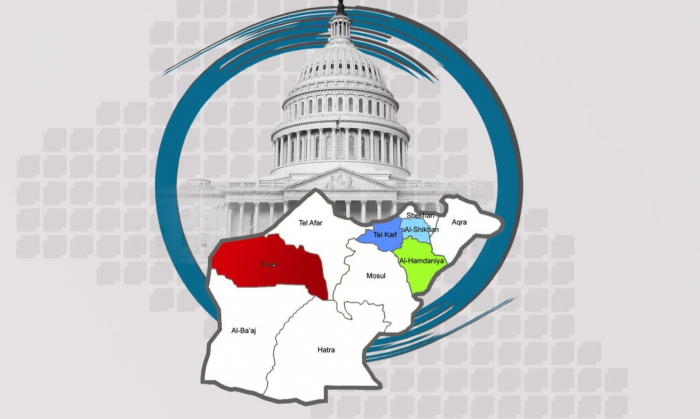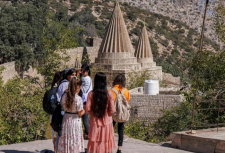Self-Government of Sinjar and the Nineveh Plain, a Difficult Dream or a Real Solution

Sinjar and the Nineveh Plain are two areas of high sensitivity because of the many problems and political conflicts that the big Iraqi blocs use to their advantage, according to interests that serve their political purposes and not those of the Yazidi indigenous people who live in Iraq.
These two regions represent the cradle of Iraqi minorities, so Sinjar is highly specific for Yazidis who are the majority in it, and the affected city witnessed the tragedy of Yazidis and their extermination in the summer of 2014. Other ethnic minorities such as Arabs and Kurds suffered much less. While the Nineveh Plain is inhabited by Christians, Assyrians, Turkmens and Kakai in addition to the indigenous Yazidi population.
It is clear that the statements of the Iraqi MP Adnan Al-Zarfi about the intention of the U.S. Congress to vote on the decision to convert the Nineveh Plain and Sinjar areas into self-governing territories have somewhat moved the standing waters in these two regions.
Self-government for Yazidi people in their ancestral territories
The issue of establishing self-government in the Nineveh Plain and Sinjar goes back mainly to the idea of creating a special region for all minorities regardless of their nationality and religion.
In 2017, the idea of a project called "Mesopotamian Region" was put forward by Yazidi, Assyrian and Turkmen leaders, who showed the idea of union among themselves and demanded self-government for the areas of the Nineveh Plain, Sinjar and Tal Afar, and they had no representation of their own.
The leaders of the project who formed the union put forward a proposal for autonomy, linked to the power in Baghdad, in an attempt to get out of the spiral of regional conflict with Baghdad, on territories that are known to be disputed, between the two sides, as stipulated by the constitution since 2005.
Who agreed and who disagreed
The draft was internationally accepted at the time and was considered one of the solutions for minority territories, but political differences between the major political blocs in Iraq prevented it, and internal disputes between the minorities themselves were the reason.
Iraq and Iraqi Kurdistan have no way of dividing between them Sinjar (Shangal) and the valleys of Nineveh.
According to Article 125 of the Iraqi Constitution, minority areas have the right to self-government in administrative and security terms.
But this article is not applied, there is also no unity among Yazidi organizations and political parties, nor is there a leader who could unite Yazidis in the region and reflect a unified opinion and the rights of Yazidis in the region.
Dengê Êzdia
Tags: #yazidisinfo #newsyazidis #iraqyazidis
Self-Government of Sinjar and the Nineveh Plain, a Difficult Dream or a Real Solution

Sinjar and the Nineveh Plain are two areas of high sensitivity because of the many problems and political conflicts that the big Iraqi blocs use to their advantage, according to interests that serve their political purposes and not those of the Yazidi indigenous people who live in Iraq.
These two regions represent the cradle of Iraqi minorities, so Sinjar is highly specific for Yazidis who are the majority in it, and the affected city witnessed the tragedy of Yazidis and their extermination in the summer of 2014. Other ethnic minorities such as Arabs and Kurds suffered much less. While the Nineveh Plain is inhabited by Christians, Assyrians, Turkmens and Kakai in addition to the indigenous Yazidi population.
It is clear that the statements of the Iraqi MP Adnan Al-Zarfi about the intention of the U.S. Congress to vote on the decision to convert the Nineveh Plain and Sinjar areas into self-governing territories have somewhat moved the standing waters in these two regions.
Self-government for Yazidi people in their ancestral territories
The issue of establishing self-government in the Nineveh Plain and Sinjar goes back mainly to the idea of creating a special region for all minorities regardless of their nationality and religion.
In 2017, the idea of a project called "Mesopotamian Region" was put forward by Yazidi, Assyrian and Turkmen leaders, who showed the idea of union among themselves and demanded self-government for the areas of the Nineveh Plain, Sinjar and Tal Afar, and they had no representation of their own.
The leaders of the project who formed the union put forward a proposal for autonomy, linked to the power in Baghdad, in an attempt to get out of the spiral of regional conflict with Baghdad, on territories that are known to be disputed, between the two sides, as stipulated by the constitution since 2005.
Who agreed and who disagreed
The draft was internationally accepted at the time and was considered one of the solutions for minority territories, but political differences between the major political blocs in Iraq prevented it, and internal disputes between the minorities themselves were the reason.
Iraq and Iraqi Kurdistan have no way of dividing between them Sinjar (Shangal) and the valleys of Nineveh.
According to Article 125 of the Iraqi Constitution, minority areas have the right to self-government in administrative and security terms.
But this article is not applied, there is also no unity among Yazidi organizations and political parties, nor is there a leader who could unite Yazidis in the region and reflect a unified opinion and the rights of Yazidis in the region.
Dengê Êzdia
Tags: #yazidisinfo #newsyazidis #iraqyazidis


























